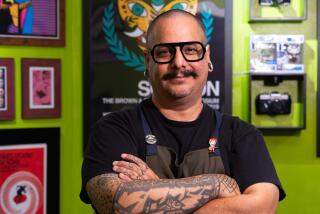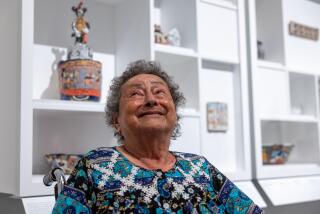The scrap-heap artiste Máximo González creates politically charged works of art from devalued currency, found objects and just plain garbage.
- Share via
In his native Argentina, Máximo González studied the usual prerequisites for an art degree — drawing and painting — but he didn’t find his true métier until he delved into other people’s garbage.
It began in 1991 when he found pieces of wood from a house about to be torn down, He made wall sculptures from them. Then in 1992 he found a tin box full of old coins on the street. He made an installation with them.
“I found money in the garbage,” the artist says, his mischievous blue eyes dancing behind oversized glasses. “After a devaluation, people threw away all their old money and coins.” Things that had been worth something were now worthless, but González saw how he could reanimate them. He drew on them, cut them up, incorporated them into sculpture, and in doing so transformed them into wry commentary on the value we assign things and the disparity between the real story and the official story.
FOR THE RECORD:
Máximo González: An earlier version of this article misspelled Máximo González’s last name as Gonzales in one place.
Today, González, 40, is known for his artful use of money — everything from banknotes upon which he has drawn his own figures to a 4-meter-wide tapestry woven from the cut-off edges of sheets of banknotes that drapes a whole wall. Both are in the 10-year survey of his work, “Máximo González: Playful” at the Los Angeles Craft and Folk Art Museum through May 6. It’s his first museum show, greenlighted by CAFAM director Suzanne Isken and guest-curated by Alma Ruiz, MOCA’s senior curator. Ruiz discovered the artist while researching her show “Poetics of the Handmade” (2007) in Mexico City, where he now resides. “I found the work so delicate and beautiful and well made,” she recalls.
A few days before the show’s opening, the third floor of CAFAM is a flurry of activity. Some two dozen works are in the show, incorporating drawing, assemblage, video and installation, much of it using found or recycled objects — including such noncurrency items as household utensils, colored light bulbs, slingshots and an old U.S. Army uniform being covered with sequins. González’s sister, Maria González, is standing on a ladder and gluing strips of paper taken from student notebooks to a mini-tornado hanging from the ceiling — a schoolboy’s desk is attached to its lower end. “No More Bets” refers to education and the whirl of information children are subjected to.
Nearby another assistant is carefully affixing pieces of “Where Have All the Flowers Gone?” onto a wall. This is a section of an epic mural made out of devalued Mexican currency and named after the famous antiwar ballad by Pete Seeger and Joe Hickerson. Here a grove of trees is being fed, one by one, into a strange, ungainly machine that excretes what looks like tanks.
“These days we have a lot of information, we have a lot of garbage,” says González, who notes that much history is embedded in the things we use and discard. “I recover all those memories and I reinterpret them.”
More to Read
The biggest entertainment stories
Get our big stories about Hollywood, film, television, music, arts, culture and more right in your inbox as soon as they publish.
You may occasionally receive promotional content from the Los Angeles Times.










